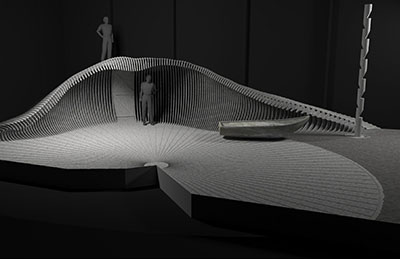A team of theatre and technology specialists, comprising members from NIDA and the Sydney Theatre Company, are currently developing a new 3D virtual reality suite that is set to revolutionise the way we design theatre sets and spaces.

Render image: Andrew Chan. A render used for the original design of Michael Scott-Mitchell’s 2013 STC production Storm Boy
A team of theatre and technology specialists, comprising members from NIDA and the Sydney Theatre Company (STC), are currently developing a new 3D virtual reality suite that is set to revolutionise the way we design theatre sets and spaces. The new software will allow set designers to create full-scale prototypes of sets and theatre spaces in a virtual environment.
At the helm of the project are NIDA Deputy Director/CEO and Head of Design for Performance, Michael Scott-Mitchell; STC’s Artistic Director and NIDA Master of Fine Arts (Directing) graduate, Kip Williams; and Chair Professor of Digital Innovation (UNSW) and Director, iCinema Research Centre, Scientia Professor Dennis Del Favero.
Intended for completion in 2019, the innovative software will harness the visualisation technology of iCinema – a stunning 360-degree projection screen at the University of New South Wales (UNSW), which becomes a three-dimensional, 360-degree space when users put on 3D goggles.
‘The full version will incorporate the use of the iCinema 360 system. The idea is that the creative team and performers in the first instance can be taken into the virtual 360-degree space wearing 3D goggles to prototype the design. This is also intended to be a tool for the scenic workshops to scrutinise any given design. In its first iteration, we will use the redevelopment of STC’s Wharf 1 as the virtual theatre and introduce virtual sets within this space,’ said Michael.
Michael was inspired to create the software from looking at the German opera industry standard of the bauprobe, where the proposed design for a production is built at full-scale in stock materials (often cardboard). It is then bumped into the theatre, allowing the creative team and the workshop to assess, make alterations, and effectively prototype the design.
NIDA and STC will work with a virtual model-maker over the coming years to build a virtual representation of the new STC theatre, and a virtual representation of Michael’s 2013 design of the STC production, Storm Boy. The software will be developed for a range of devices in addition to the iCinema 360-degree virtual environment, with NIDA also utilising the recently acquired ‘mega LED screen’ – an 8x3m digital display where another version of the virtual 3D interface will be tested.
‘Our Head of Performance Practices, Dr Oliver Watts, will be working as a dramaturg, documenting the process and using it as a research vehicle for himself and NIDA,’ commented Michael. ‘I’ll work closely with the virtual model-maker until the software is completed in 2019. We’re keen to have the virtual-model-maker working for much of the development at NIDA, so that designers as well as other courses are able to see the development of this technology.’
The technology will also have an advanced virtual lighting capacity where users can light the space and the set. Nick Schlieper, one of Australia’s leading lighting designers, will be coordinating this aspect to the project.
‘The intention is to build a virtual representation of each lighting instrument, emulating their properties,’ commented Michael. ‘The virtual prototyping will include, but not be limited to, physical changes to the set, its location within the theatre space, remapping textures (including colour palette), and viewing the design from any seat within the theatre. In a nutshell, the director and designer will be able to take a virtual walk within the set and then move back into the auditorium to view the design. Added to this, the ability to accurately represent the lighting design will be an enormous asset to the creative team. The planned timing of the launch of this software will coincide with the launch of the redevelopment of STC’s Wharf 1 theatre. This is a great opportunity for NIDA to enhance its relationship with STC through this creative exploration.’
